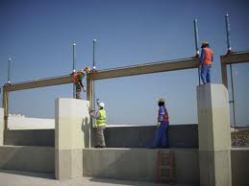The Palmer-Bowlus Flume was originally designed for use in manholes. It is still most commonly installed in pipelines and manholes. However, it is also suitable for open channel applications when a proper transition is used in front of the flume. The flume can use a simple power equation or a more accurate polynomial equation. It can be used with any of the meters available on the market today.
ADVANTAGES
- The Palmer-Bowlus “U” shaped design and relatively short length make it ideal for retrofitting existing piping systems. This design also allows 4” – 12” flumes to fit through an existing manhole opening.
- Larger Palmer-Bowlus flumes (typically 48” and larger) can sometimes provide a good alternative to the Parshall. They often give better flow resolution, and may cost less to install.
- The flume design accelerates the flow as it passes through the flume thus making it “self-cleaning”. Its wide throat is great for passing larger solids and debris.
- The raised throat helps create positive head for the water to pass out and away from the flume.
- The Palmer-Bowlus can tolerate a high level of submergence: 85 – 90%!
DISADVANTAGES
- The Palmer-Bowlus flume was originally designed to fit pipes the same size as the flume. It is now a common practice to install a smaller Palmer-Bowlus flume in a larger channel or pipe. This however, may limit the total amount of flow range that can be accurately used if the wider opening significantly affects the downstream tail water. Above the lower flow range limit, you could experience a progressive over-discharge resulting in a 3 – 5% low reading.
- Although the Palmer-Bowlus has a fairly good flow range, it is typically not a good style of flume for measuring low flows.
- Flat or low sloped inlet pipes and channels could create solids settling because of low velocities and the raised throat design. This is especially true during low flow periods. However, the solids will normally pass through the flume when flow picks up.
APPLICATION NOTES: Also see “General Flume Design Data”
- The most common calibration errors are:
- Not having the correct measurement location. This should be upstream of the entrance ramp, a distance equal to half the diameter of the flume, or 0/2.
- Not having the correct zero point. The zero point is level with the raised throat of the flume. At zero flow you have standing water at the measurement point.
- Do not expect accurate predictable readings for flows under 5 to 10 GPM even in the smallest (4”) Palmer-Bowlus flume.
- The Palmer-Bowlus flume will experience submerged conditions at about 85% – 90% of the downstream depth compared to the upstream depth. If at all possible do not design or install a new flume system with the anticipation of it operating in a submerged state.
- One of the most common misunderstandings is the use of the term “Insert” as it relates to a Palmer-Bowlus flume. A Palmer-Bowlus “Insert” is a flume without an approach section, staff gage, end flanges or mounting slips. “Inserts” are made to fit into a pipe that is the same size as the flume, i.e….a true 6” l.D. pipe will require a 6” 0.0. “Insert” flume.
Note:
- The gauging point will be in the pipe or channel ahead of the flume.
- The true pipe l.D. must be confirmed. Plastic and clay pipes frequently have an irregular ID. — 6” pipe may actually be 5 3/4” ID.
- Palmer-Bowlus Insert flumes were originally intended for temporary installations such as storm water and I & I studies.
A Palmer-Bowlus “Insert” with Approach is a modification that is sometimes used in order to include the staff gage within the flume. This style will often be used in “roughed-in” U-channels.
Note:
- The same installation requirements apply, pipe ID. and flume 0.D. must match.
- Probe cavities or instrument mountings that increase the O.D. of the flume wall are not allowed.
- Plasti-Fab has standard molds for this type of flume from 4” through 12” diameter. Flume length including the approach of 3D+1”.
A Palmer-Bowlus Cutback or “exit” style flume is another modification of the Insert flume. In this version of the downstream vertical walls of the flume have been removed to match the height of the half pipe. This allows the outlet end of the flume to be inserted into the downstream pipeline.
Note:
- Again, the same installation requirements apply.
- The cutback flume usually does not include an approach section.
- The upper flow range will be restricted to about 60 or 70% of full pipe.
- Use the conservative peak flow as the upper limit.
The Palmer-Bowlus with Approach is sometimes referred to as a “Permanent” or standard flume. The normal length with an approach of 4D + 1”. These flumes have side clips for keying into concrete and a structural flange around both ends. The approach section is desirable because it provides a control area in the flume for measurement, a built-in gage, and a place to mount a meter.



